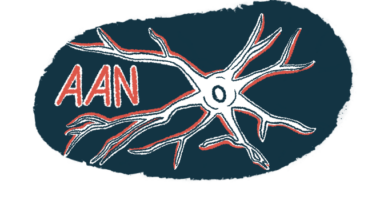AAN 2023: Fewer motor symptoms found with prasinezumab for 3 years
Longer treatment time shows benefit in PASADENA trial in Parkinson's

Parkinson’s disease patients treated with prasinezumab for three years — as part of a long-term extension of the Phase 2 PASADENA clinical trial — were shown to be at a lower risk of motor symptom progression and motor complications than patients who started treatment a year later, according to a new exploratory analysis.
These findings suggest possible benefits of longer-term use of the investigational therapy.
In previous trial analyses, prasinezumab had failed to meet its main goal, after one year of treatment, of easing Parkinson’s disease symptom severity compared with a placebo.
Altogether, the new analysis “suggests a potential effect of prasinezumab on delaying motor progression,” Paulo Pacheco Fontoura, MD, PhD, said in a presentation at the American Academy of Neurology (AAN) 2023 Annual Meeting, held April 22-27 in Boston and virtually.
Still, “further studies need to be performed to confirm these findings,” said Fontoura, the global head and senior vice president of neuroscience, immunology, ophthalmology, infectious and rare diseases at Roche, which is co-developing the therapy with Prothena Biosciences.
New data comes from trial’s extension phase
Prasinezumab is an antibody designed to break up clumps of the alpha-synuclein protein that build to toxic levels in Parkinson’s disease.
After it was found to reduce alpha-synuclein in the blood of Parkinson’s patients in a Phase 1 trial (NCT02157714), the Phase 2 PASADENA trial (NCT03100149) was launched to investigate prasinezumab’s safety and efficacy in people with early-stage Parkinson’s. PASADENA enrolled 316 participants across the U.S. and in Europe.
The trial was conducted in three parts. In the first part, patients received one of two doses of prasinezumab (1,500 or 4,500 mg) or a placebo, given as an into-the-vein (intravenous) infusion every four weeks for a year.
During the trial’s second year, those already using the experimental therapy — the early-start group — continued to do so, while those initially on the placebo switched to either of the two doses of prasinezumab. These individuals were called the late-start group.
Finally, patients could enter an open-label extension (OLE) phase, in which all are continuing to receive the therapy’s low dose.
Overall, the trial’s main goal was to assess changes in Parkinson’s symptom severity after the first year. This was assessed by total scores on the Movement Disorder Society-Unified Parkinson’s Disease Rating Scale (MDS-UPDRS).
Although well-tolerated, prasinezumab failed to meet that goal, with no significant changes in total MDS-UPDRS scores with treatment relative to the placebo. Further, no significant differences were found between the early-start and late-start groups after two years.
However, evidence suggested that prasinezumab could lead to improvements in scores on the MDS-UPDRS part 3, the subsection of the MDS-UPDRS that concerns motor symptoms, after the trial’s first and second year.
Now, in an AAN talk titled “Exploratory Delayed-Start Analysis Of PASADENA Part 3 52-Week OLE Evaluating Prasinezumab Efficacy On Motor Progression And Complications In Early-Stage PD,” Fontoura shared new data demonstrating a potential effect of prasinezumab on motor symptom progression.
The analysis focused on data as of the end of the first year in the OLE. At that point, those in the early-start group had been receiving prasinezumab for three years and those in the late-start group had been on the therapy for two years.
A clinically meaningful worsening of motor symptoms was defined as at least a five-point increase in scores on the MDS-UPDRS Part 3.
After three years, 84.4% of those in the early-start group had experienced motor progression, compared with 92.4% of the late-start group, corresponding to about a 22% reduction in the risk of motor progression for early starters.
The median time until motor progression was 169 days, or about 5.5 months, for the late-start group. For the early-start group, it was 224 days, or more than seven months.
Prasinezumab also was associated with a significant delay in the time until patients experienced motor complications, defined as a one-point increase on any of the items contained in the MDS-UPDRS part 4 subscale. These include motor fluctuations, involuntary movements known as dyskinesias, and involuntary muscle contractions or dystonia.
The open-label portion [of the trial] will continue for at least five years and we will keep monitoring these patients … and keep reporting these data as we get it.
At the time of the analysis, 58.8% of early starters and 68.6% of late starters had experienced motor complications. Again, patients who started using the investigational therapy earlier were at about a 21% lower risk of experiencing such complications than were their counterparts with a delayed start.
“The open-label portion [of the trial] will continue for at least five years and we will keep monitoring these patients … and keep reporting these data as we get it,” Fontoura said.
Meanwhile, the Phase 2b PADOVA trial (NCT04777331) is evaluating the safety and efficacy of prasinezumab against a placebo in people with early-stage disease who are on stable Parkinson’s medications. That trial is expected to finish in 2026.
Note: The Parkinson’s News Today team is providing coverage of the American Academy of Neurology (AAN) 2023 Annual Meeting April 22-27. Go here to see the latest stories from the conference.







